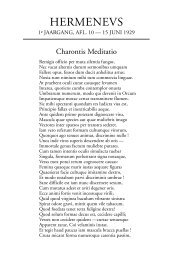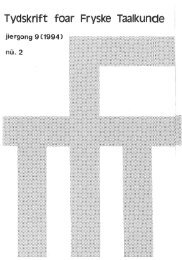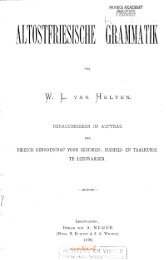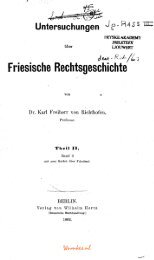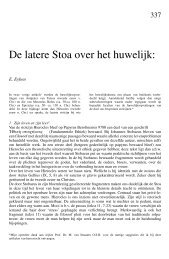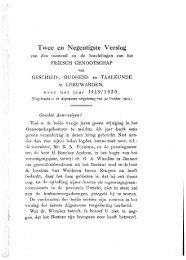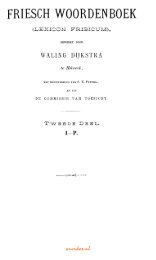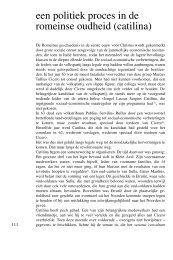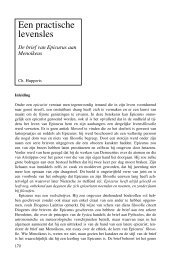It wurk fan Gysbert Japix n-2 - Tresoar
It wurk fan Gysbert Japix n-2 - Tresoar
It wurk fan Gysbert Japix n-2 - Tresoar
Create successful ePaper yourself
Turn your PDF publications into a flip-book with our unique Google optimized e-Paper software.
earch for models, the spotting of topoi and consideration of the genre the work<br />
might fit. Research into the relation with reality is focussed on indicating elements of<br />
time and place in the text and facts from the life of the author, and on the formulation<br />
of the possible functions of a text in relation to the personal life of the author,<br />
contemporaneous topics and social needs. In view of this approach the texts are dated<br />
as precisely as possible, and an Interpretation of each text is given. The scheme re-<br />
«ults in an analysis model in six parts which is described under the heading Textual<br />
Commentary, Approach (5.1). The analysis is applied to a selection from the work of<br />
the poet, in which representativeness was aimed at, and will be found in Chapter 5.<br />
In Chapter 4, a separate investigation is made into the conditions of the author's life<br />
and his outlook upon it, as parts of the reality which has no directly visible link with<br />
the text itself.<br />
The argument is based on the combination of literary and historical research. This<br />
combination has not been used in GJ studies so far. The choice foi such an approach<br />
was made independently of Spies 1987a, who presents a comparable scheme. The<br />
frame of reference of the literary criticism is rhetoric. The historical research is tentative.<br />
The choice for a text-by-text discussion has its origin in the notion that it is not<br />
meaningful to make general statements about the reality content (or literary content)<br />
of literature if they are not based on penetrating research into individual texts.<br />
A number of flaws in the two extant editions of GJ's works (Epkema 1821, published<br />
in 1822, and Brouwer 1936/1966) make a new publication desirable. In order to<br />
meet the aims formulated above, a text edition has been added to this study, which<br />
appears as Part I. Problems of transliteration and editing in facsimile form are discussed<br />
in Chapter 2. A description of editions and manuscripts follows in Chapter 3.<br />
Üiscussion of editions concentrates on the question of the history of their origin. A<br />
contribution to accounting for the origin of a work can be made through knowledge<br />
of the audience that read (or did not read) it and of the nature of the interest the work<br />
aroused. This is assumed to have greater significance to the extent that readers lived<br />
closer in time to GJ. Consequently, attention is also paid to these aspects of the reception<br />
of GJ's work, particularly for the period up to 1822, when a new edition appeared.<br />
The analysis of the subscription list to this edition constitutes a welcome addition<br />
to the sparse data about readers from 1822 back to 1640, the year in which work of<br />
GJ's hand was published for the first time.<br />
<strong>It</strong> can be said in general that I have aimed at including into the investigation all Information<br />
about GJ and his work which has come down to us over the course of the<br />
centuries. This applies to secondary literature as much as to archive materials. Data<br />
from secondary literature have been checked against their sources.<br />
Textual tradition (3.1)<br />
About 1658, GJ seems to have conceived the plan of collecting his Frisian oeuvre<br />
in Friesche Rymlerye the way it appeared in 1668, two years after his death. The book<br />
may never have been placed upon the market.<br />
The expanded 1668 re-edition which Gabbema published in 1681 contained not<br />
only new texts by GJ but also two introductions in the form of dedications, a grammar<br />
of Frisian, a treatise on Frisian orthography, and a specimen of Old Frisian in<br />
two versions. The relation of both the grammar and Old Frisian to GJ is not clear.<br />
wumkes.nl<br />
511





